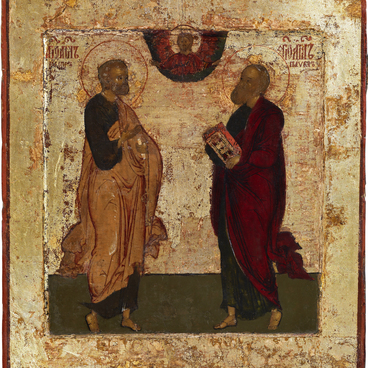The Holy Trinity of The Old Testament is one of the iconographic methods of painting God the Father, God the Son and God the Holy Spirit. The name comes from the Old Testament, the part of the Bible that describes events before the Nativity of Christ. The icons The Holy Trinity of The Old Testament or Abraham’s Hospitality depicted the apparition of three angles to the forefather: it is mentioned in the Book of Genesis: And God appeared to him at the oak grove of Mamre when he was sitting at the entrance of the tent on a hot day. He raised his eyes and looked, and saw three Men standing in front of him. In early icons the angels used to be painted emphatically identical - coordinately (isocephalically) and in clothes hardly different in colour. Later, icon painters started to distinguish one of the angels: he may either have a crossed nimbus or be located in the center of the composition.
The Holy Trinity of The Old Testament
Creation period
Mid-17th century, painting: 19th century
Dimensions
31,3x26,8 cm
Technique
Wood, silver, tempera (icon), gold plating, stamp printing (metal cover)
Collection
Exhibition
3
Open in app#1
Unknown Author
The Holy Trinity of The Old Testament
#2
#3
About icon
#4
The Holy Trinity of The Old Testament icon that is in the collection of the Rybinsk Museum Reserve was created in mid-17th century. Its author is unknown.
#5
Scientists believe that as a model the icon painter used the icon of the Most Holy Trinity by Andrei Rublev: that exact sacred image became an ideal for next generations of icon painters. Like Rublev, the unknown painter did not include the forefather Abraham, his wife Sarah and the episode of slaughtering the sacrificial calf.
#6
The icon cover is made of silver with stamp-printed floral ornament. The image is created with egg-based paints (tempera), decorated with thin golden strokes (gold hatching) and coated with a layer of boiled linseed oil.
Boiled linseed oil tended to darken with time, in some 60-90 years it could become completely nontransparent. In such cases icons had to be restored. Icon painters of past centuries sometimes applied a new coat of paint over the old coat of boiled linseed oil. By so doing, they could slightly modify the subject or paint a totally new icon. That restoration method was called overpainting. There existed another method, when the restoration painter fully replicated the image contours and partially renovated the coat of paint. That method was called repainting. The icon of the Rybinsk Museum collection contains repaints of the 19th century.
Before the revolution the icon was kept in the collection of the art connoisseur, President of the Academy of Fine Arts, Chief Procurator of the Synod Count Alexey Musin-Pushkin. His estate, called Borisogleb, was located not far from Rybinsk, in the Mologsky District. After the revolution the estate housed a school, while the whole collection of the Musin-Pushkins was transferred to the museum. Later on, the mansion was dismantled and the lands of the estate were flooded with the Rybinsk water reservoir.
Boiled linseed oil tended to darken with time, in some 60-90 years it could become completely nontransparent. In such cases icons had to be restored. Icon painters of past centuries sometimes applied a new coat of paint over the old coat of boiled linseed oil. By so doing, they could slightly modify the subject or paint a totally new icon. That restoration method was called overpainting. There existed another method, when the restoration painter fully replicated the image contours and partially renovated the coat of paint. That method was called repainting. The icon of the Rybinsk Museum collection contains repaints of the 19th century.
Before the revolution the icon was kept in the collection of the art connoisseur, President of the Academy of Fine Arts, Chief Procurator of the Synod Count Alexey Musin-Pushkin. His estate, called Borisogleb, was located not far from Rybinsk, in the Mologsky District. After the revolution the estate housed a school, while the whole collection of the Musin-Pushkins was transferred to the museum. Later on, the mansion was dismantled and the lands of the estate were flooded with the Rybinsk water reservoir.
#7
Rybinsk Museum Reserve
read morehide
00:00
00:00
1x
The Holy Trinity of The Old Testament
Creation period
Mid-17th century, painting: 19th century
Dimensions
31,3x26,8 cm
Technique
Wood, silver, tempera (icon), gold plating, stamp printing (metal cover)
Collection
Exhibition
3
Open in app
Share

